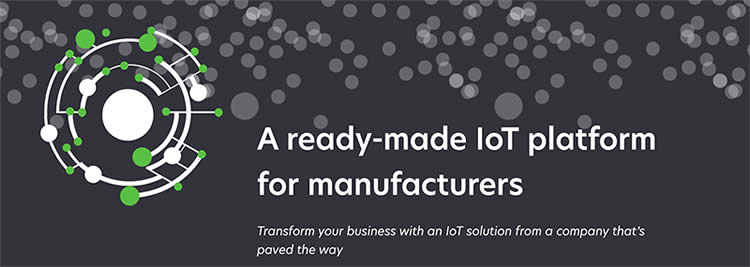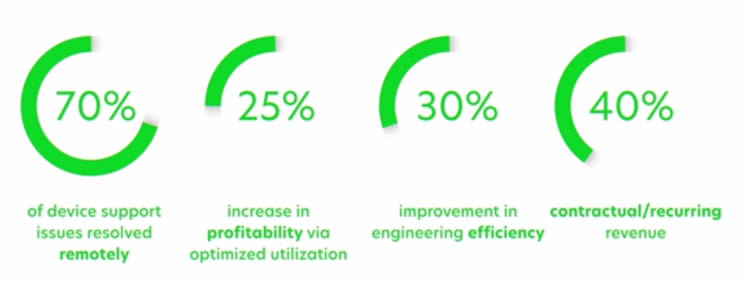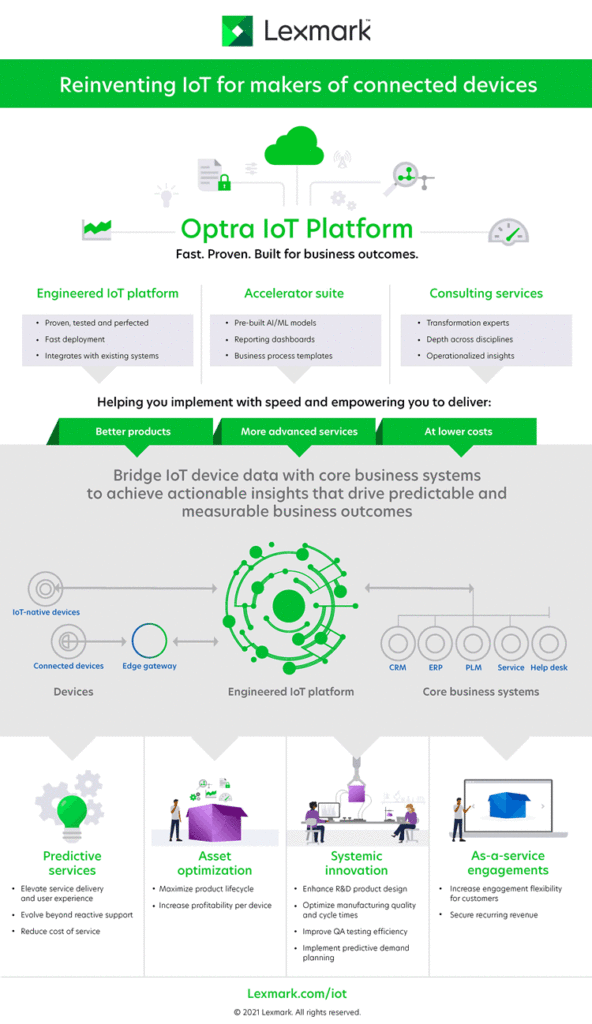With the launch of the Optra IoT platform, Lexmark expands into the IoT space. Read why that is a – perhaps surprising but – logical evolution and why Lexmark intends to launch more IoT solutions.
Lexmark is still mainly known as a global player in the print and imaging market and a Worldwide Leader in Managed Print and Document Services.
We unleashed the power of IoT and built a solution that we have used for years in our own business to achieve measurable benefits for our customers and ourselves. Lexmark Optra IoT Solutions can do the same for other companies. (Allen Waugerman, president and CEO of Lexmark)
As is the case with others in that industry, connectivity, intelligent software, and cloud-enabled technologies have played an increasingly important role for years. And so has IoT (the Internet of Things).
Lexmark is now taking an interesting step into the world of IoT in businesses, with the “launch” of the Lexmark Optra IoT platform as the first of a series of IoT solutions in the new Optra portfolio.

The place of IoT in Lexmark’s digital thread strategy
For industry watchers, it’s probably not that much of a surprise since the move results from a clear vision, long transformation, and experience with IoT within the company.
Printers and other advanced printing and imaging solutions, such as high-end document scanners, have been incorporating sensors for years to drive the ever-smarter solutions that are constantly emerging.
In addition, Lexmark has used IoT technologies for quite some time now as part of its offering, mainly for service and maintenance (predictive maintenance and services), and asset optimization.
Years of honing and perfecting an IoT platform to run our managed print services business has led to an expansion of our company (Allen Waugerman, President and CEO, Lexmark)
Lexmark was one of the first to see printers as part of an Internet of Everything environment. In the summer of 2019, former Lexmark CIO Brad Clay (since early 2021 the CDO of GlobalFoundries) made that vision clear in a guest post for Microsoft.
In the post, which was mostly about printing in the cloud, Clay talked about the fact that Lexmark had been busy reinventing itself over the past decade with a “digital thread strategy.”
In doing so, the company saw the printer less as a standalone device and more as an IoT-enabled business component. Clay pointed out that an average printer was already equipped with 120 sensors gathering data to improve service.

Lexmark’s Connected Field Service uses the internal Lexmark IoT hub, which allows predictive diagnostics to be made for individual printers and sends service technicians an alert if needed.
Making digital transformation easier and helping solve the IoT data business challenge
All that IoT expertise and the IoT platform, which existed within the framework of Lexmark’s managed print services offering, is now being offered in the market in the form of the Lexmark Optra IoT platform.
It’s an excellent example of expanding the business model through digital transformation and leveraging cloud computing, smart sensors, and other technologies (see below).
Lexmark uses its IoT architecture to manage more than 1 million printers and devices, analyzing terabytes of device performance data per week.
Lexmark wants to help other companies realize their own digital transformation strategy with the Lexmark Optra IoT platform, which was announced at the – virtual – 2021 edition of IoT Tech Expo North America – and, as said, is the first step in an “expansion into the IoT space,” as Phil Carter, Director, IoT and Managed Print Services at Lexmark, put it.
Vishal Gupta, who joined Lexmark in February 2021, coming from from Unisys, where he led a team of more than 1,500 engineers and was responsible for all products and platforms, explained why Lexmark launches the Lexmark Optra IoT Platform now. More specifically, Gupta feels that the time for IoT is now because other enabling technologies are also ready now. He mentions 5G to connect the devices (no mention of IoT connectivity means such as LPWAN), edge computing to support real-time video and audio use cases, cloud, and algorithms to move from data to decision (remember DIKW).

The Lexmark Optra IoT Platform is positioned as “a ready-made IoT solution to help customers jumpstart their business transformation, creating better products and more advanced services at lower costs.”
The potential of IoT for business gains through predictive services, remote support, asset optimization, and other aspects, is clear. According to Lexmark, its platform enabled it to resolve 70 percent of support issues remotely, achieve an increase in profitability of 25 percent via optimized utilization of its printers, improve engineering efficiency by 30 percent, and increase contractual/recurring revenue by 40 percent.

The platform is available in North America and, for now, some European markets. It will be interesting to see how Lexmark’s range of IoT solutions will be adopted over time. The IoT platform market is already quite busy. Yet, Lexmark clearly wants to offer a solution for manufacturers that is based on its proven success and journey.
For many, starting with IoT projects is still quite hard. There’s a reason why Lexmark cites data from McKinsey estimating that 84% of companies working on IoT are stuck in pilot mode in its press release. Among the main reasons: “the vast amount of data that exists in silos across business applications and beyond the organization’s walls.”
And that, of course, in the end, is the business where printing and imaging courses are active in with the ongoing challenge of uncovering actionable insights from the data, among others due to data management challenges.
Moreover, in an initial phase, CEO Waugerman says, Lexmark primarily targets manufacturers (OEMs) of mid-size devices with its IoT solution(s) – indeed, like the equipment it has the most experience with. The platform has been used and tested across several verticals before where connecting mid-size equipment makes sense. Examples include manufacturers of healthcare devices but also types of equipment one would find in specific Industry 4.0 environments, such as the manufacturing of equipment for connected mining.
The Optra IoT Platform creates and curates a product digital thread by which device performance can be accessed and connected from design in the lab, to manufacturing on the line, to quality checks at distribution centers, and then ongoing reliability in the field (Phil Carter, Director of IoT and Managed Print Services, Lexmark)
Lexmark’s Optra IoT platform – aiming to reinvent IoT for makers of connected devices
In an infographic entitled “Reinventing IoT for makers of connected devices,” Lexmark makes clear for whom the IoT platform is intended and what its fundamental value proposition is, with the words “fast/speed”, “proven” and “business outcomes” being omnipresent in all communications.
The infographic also shows the services, integrations, and benefits of the solution per Lexmark. You can watch Lexmark’s President and Chief Executive Officer, Allen Waugerman, and Vishal Gupta, Senior Vice President, Chief Information and Technology Officer, announce the Optra IoT solutions and a short Optra IoT Platform introduction via this link.
From the press release – and as made clear in the infographic: the solution includes
- An engineered platform that enables manufacturers to aggregate and operationalize siloed data from IoT-enabled devices and core business systems (CRM, ERP, PLM and the likes).
- A suite of accelerators (that need for speed), including algorithms, pre-built machine learning and artificial intelligence models, reporting dashboards, and business process templates.
- Support by a team of consultants with transformation expertise to help customers navigate the IoT journey and generate value.

All images belong to their respective mentioned owners and serve illustration purposes only.

